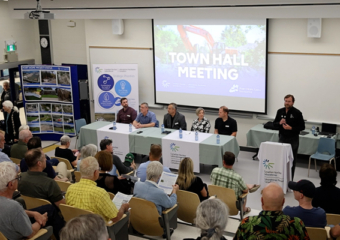One of the most integral parts of Port Hope Area Initiative (PHAI) cleanup activities is environmental monitoring. This stringent monitoring ensures that measures put in place to lessen the impact of the cleanup work on the community is effective.
“Our tasks ensure that human health and the environment are protected. It also gives us data to determine if further actions are needed to reduce any project effects,” said Nicole Van Dijk, Environmental Protection Lead.
On current PHAI project sites, dust and noise levels are being carefully monitored and have been compared to baseline information collected prior to start of work. These levels will be continuously monitored during active work.
At the Port Hope Harbour site, sediment removed during dredging will be dewatered at the Centre Pier before it is transported to the waste management facility for storage. With the possibility of nuisance odours at the Port Hope waterfront as a result, monitoring is now being performed for potential odour generating activities.
Dredged material quickly breaks down once exposed to the air. In order to accurately capture the possible impact of the work, a CNL contractor will be performing baseline studies in Port Hope in the next few weeks. Contractors will be seen using an unusual looking piece of equipment called a Nasal Ranger that will determine and quantify nuisance odours.
The receptors will be tested at various locations per day depending on the direction of the wind. The frequency will increase when dredging starts or may become more frequent depending on conditions.
“This data will be very helpful when making decisions about measures to improve the conditions, if this becomes necessary,” said Van Dijk.
As with other monitoring, action will only be necessary if exceedances are recorded.
“We will continue to work with both contractors and residents to ensure that impacts are minimised during PHAI work,” added Van Dijk.
For more information on PHAI environmental monitoring, click here.
Residents and other members of the public are encouraged to contact CNL if they have questions or concerns and to visit PHAI.ca for up-to-date project information.




